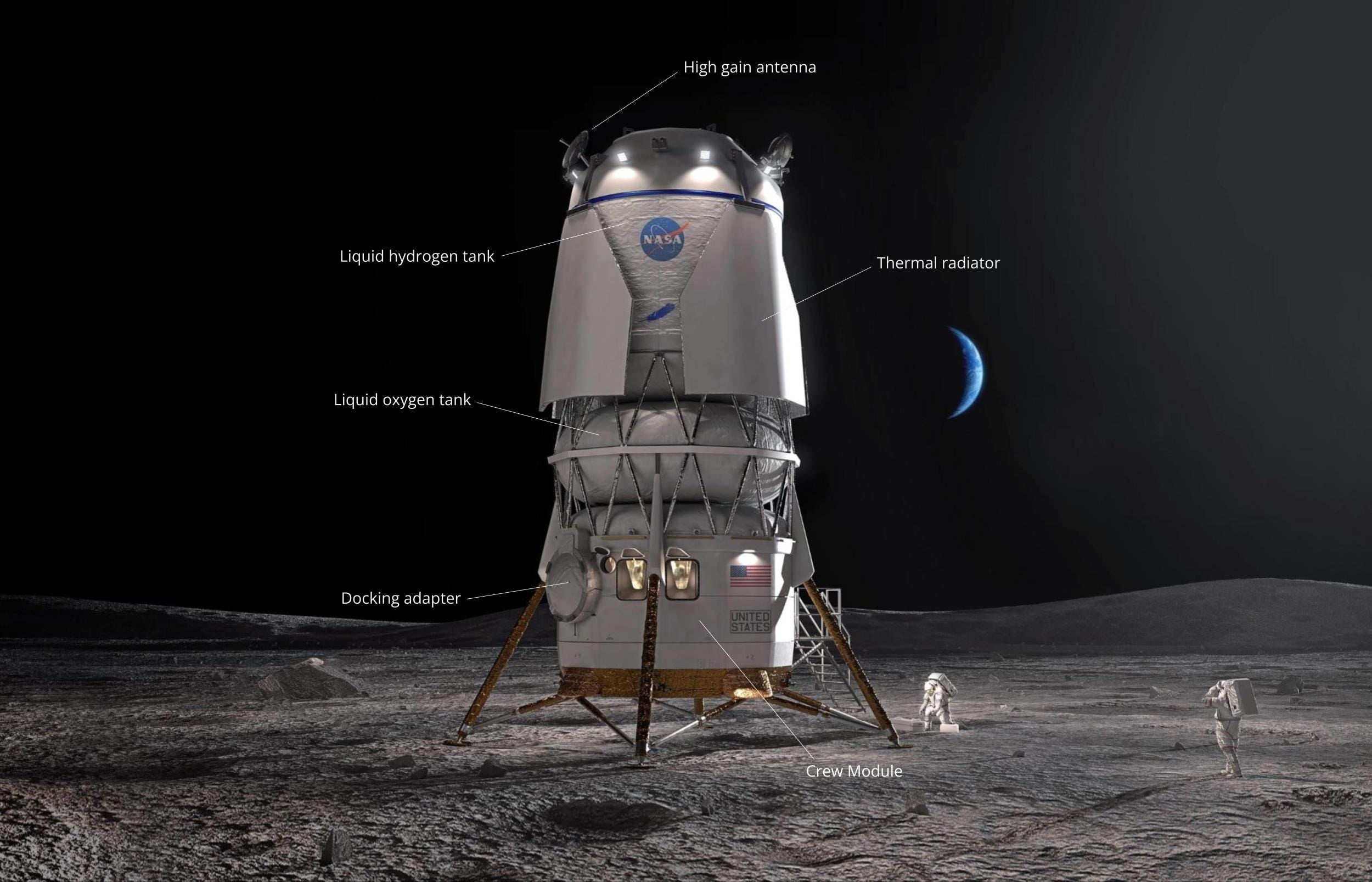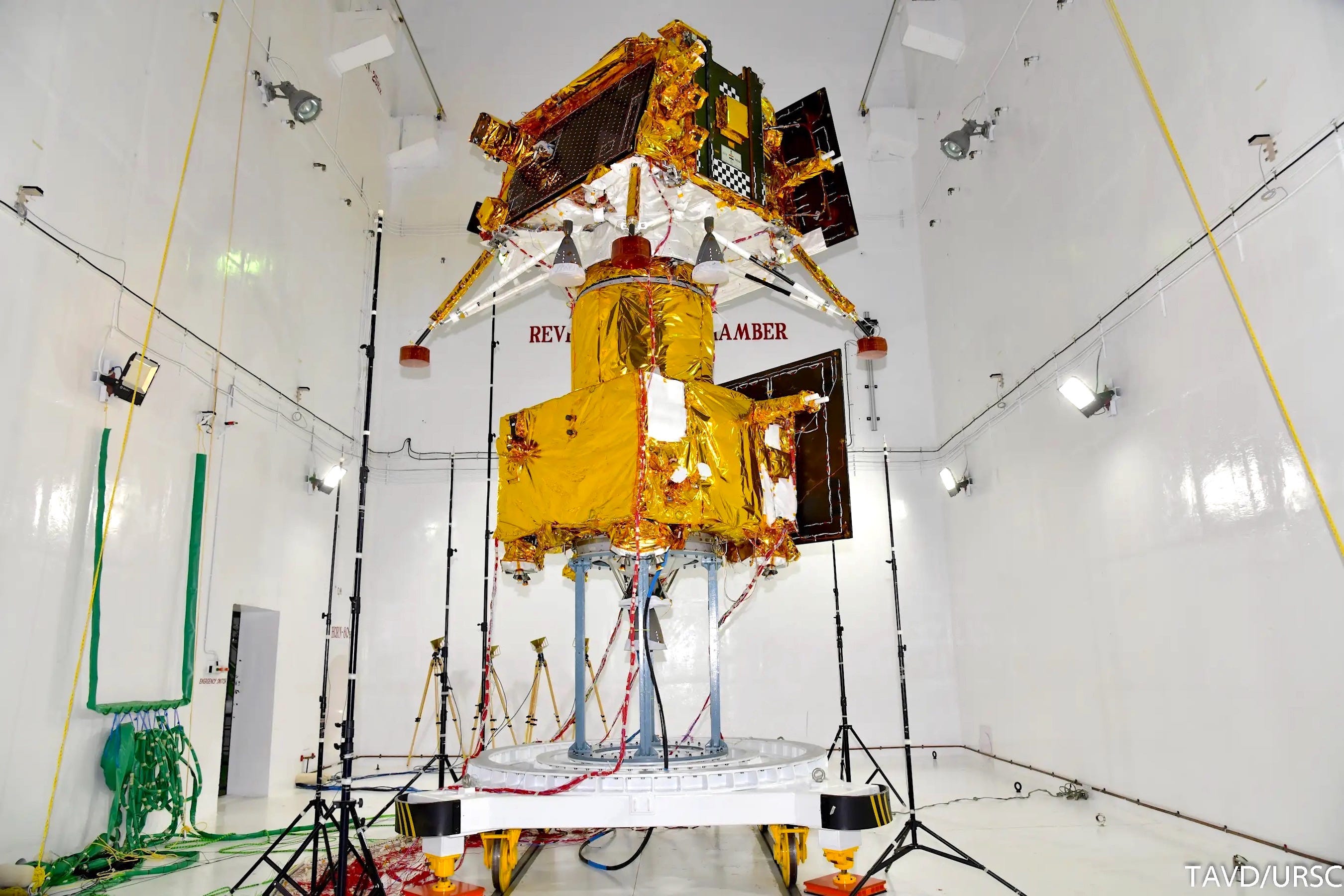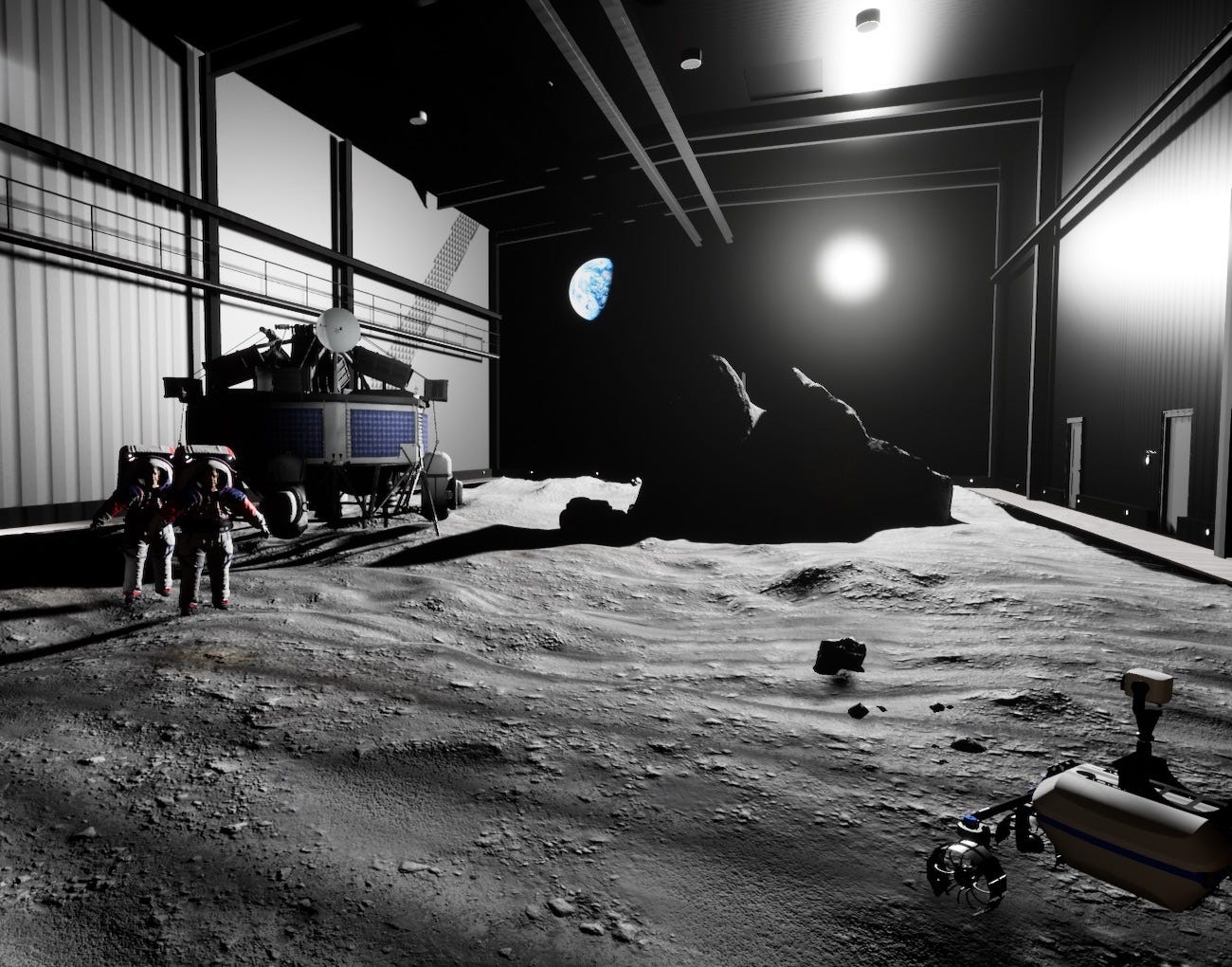Moon Monday #128: Welcoming the Blue Moon, a Chandrayaan launch, lune hops, and more
I only recently learnt that months were originally called moonths. I’m so going to say moonths now every chance I get. The word has been duly added to my device dictionaries. 🌝
NASA selects Blue Moon to compete with SpaceX Lunar Starship for crewed Artemis lunar landings
NASA has selected Blue Origin and its “National Team” to build what the agency calls a “sustainable” lunar lander, which can regularly carry humans between the Moon’s surface and its orbit. To begin with, NASA has tasked the National Team—which includes Blue Origin, Lockheed Martin, Draper, Boeing, Astrobotic, and Honeybee Robotics—with safely landing astronauts on the Moon in 2029 for the agency’s Artemis V mission.
The National Team’s 16-meter tall “Blue Moon” lander is the second such “sustainable” crewed Mooncraft NASA is co-funding following the agency’s selection of SpaceX’s upgraded Lunar Starship last year, which is currently targeting landing astronauts for Artemis IV in 2028. SpaceX and Blue Origin will bid against each other for crewed landings following Artemis V, giving the agency competition-fueled cost-effectiveness as well redundancy as it hopes to have astronauts visit Luna every year leading up to a sustained Artemis Moonbase.
Artemis V
Notably, even though NASA chose Blue Moon based on the agency’s own sustainable lander requirements, which include four astronauts being able to live and work for a month on the Moon, the agency’s press release states that Blue Moon will only host two astronauts for a week on Luna for Artemis V.
NASA’s $3.4 billion fixed price, milestone-based contract to the National Team includes Blue Moon performing a full-scale uncrewed lunar landing demonstration by 2028 before crew can fly on Artemis V. This Uncrewed Flight Test (UFT) will even demonstrate life support systems and ascent back to lunar orbit despite NASA only requiring precision lunar landing as a baseline.
In the Source Selection Statement detailing why NASA chose Blue Moon as the second crewed Artemis lander, the agency noted Blue’s only eligible competitor Dynetics bid a “substantially higher” (undisclosed) amount. It wasn’t the most important consideration though. Technical strengths such as having a full-scale uncrewed mission and faster maturing of key technologies played in Blue Moon’s favor, as Jeff Foust elaborates.

Colder than lunar ice
Docking with every crewed Blue Moon lander in lunar orbit will be a Lockheed Martin-built “Cislunar Transporter”, which will bring 20+ tons of liquid hydrogen and liquid oxygen from Earth orbit to transfer to Blue Moon for enabling lunar landing and ascent.
To prevent liquid hydrogen from notoriously boiling off during the coasting phase of the cislunar transporter, and time spent by Blue Moon in lunar orbit and on the surface, Blue Origin says the company is working on a solar-powered cryocooler that operates at 20 degrees above absolute zero. That’s 5–10 degrees colder than some of the coldest known permanently shadowed regions on the Moon’s poles. Blue Origin is banking on this hydrogen storage technology to open up sustainable deep space missions across our Solar System, including by using water ice extracted from the Moon’s permanently shadowed regions to fuel hardware for such missions.
NASA wants crewed non-polar and cargo-for-crew Moon missions too
As part of the sustainable lander requirements, NASA intriguingly mentioned last year that it wanted the proposed lander designs to also support short-stay two-astronaut missions at non-polar regions across the Moon, including the farside. This may sound like a minor enhancement over polar crewed missions but is huge as it would lay the foundation for landing and living on the Moon anywhere—however briefly. To that end, NASA’s Source Selection Statement praises Blue Moon’s proposed non-polar capabilities:
Blue Origin proposes an excess capability to provide Non-Polar Surface Access to six of the six sites listed for NASA DRM-H-001b (Non-Polar Sortie Mission Variant), which demonstrates flexibility and added margin against the non-polar NASA DRM.
This is something NASA said in the statement Dynetics’ proposals offered as well. Lunar Starship can naturally be expected to feature said capability too.
Moreover, as mentioned at the LEAG 2022 Annual Meeting, NASA plans to complement the crewed landers and help sustain & extend astronaut stays post-2030 under Artemis Base Camp with “Human-Class Cargo Delivery Landers” or HDL. These landers, which could be built by a number of companies including SpaceX and Blue Origin, should be able to deliver at least 12,000 kilograms of cargo to the Moon’s surface, which could include crew-critical supplies, scientific payloads, large rovers, habitat modules, and more. To that end, NASA mentions in the aforementioned Blue Moon selection statement the following:
NASA plans to leverage crewed lander development activities to procure and certify the design of landers capable of human-class cargo delivery via specific Contract Line Item Numbers (CLINs).
And sure enough, as Jeff Foust notes, Blue Origin is planning to build a cargo version of Blue Moon that can transport 20,000 to 30,000 kilograms to the Moon. SpaceX is also making a cargo variant of Lunar Starship. In fact, NASA selected it in 2019 as a biddable option for the CLPS program, which aims to regularly send the agency-funded science & technology payloads on commercial Moon landers.
All great but the budget
In the FY 2023 budget, NASA received the requested $1.49 billion in funding for the development of said crewed lunar landers. For FY 2024, NASA has requested ~$400 million more. The US Congress approving that level of funding later this year will be key to keeping the Blue Moon lander on schedule. NASA’s chief official for crewed deep space exploration, James Free, recently warned that even the current best case scenario of the US Congress fully funding NASA’s FY 2024 budget request doesn’t help the fact that the Artemis program’s overall cost is ballooning.

Many thanks to Epsilon3 for sponsoring this week’s Moon Monday.
Mission updates

- ISRO is aiming to launch the Chandrayaan 3 Moon lander in the second week of July, Times of India reports. ISRO has begun final assembly of the lander’s payloads at the U R Rao Satellite Center in Bengaluru, with integration and final assessments to follow before Chandrayaan 3 is sent to Sriharikota for launch preparations. As part of a standard series of space simulating tests, Chandrayaan 3 notably successfully passed launch survival testing in March and electromagnetic interference testing in February.
- The NASA-funded and Advanced Space-led CAPSTONE CubeSat has completed six months it its intended unique Near-Rectilinear Halo Orbit. Since November 2022, CAPSTONE has helped refine our mathematical models of this fuel-efficient orbit based on the exact propellant and power it needed to maintain desired operations in said orbit. CAPSTONE is a literal pathfinding mission for the NASA-led international Gateway astronaut station launching mid-decade, and the mission team is publishing papers to that end. The CAPSTONE team deserves the fruits of this success, for they practically fully recovered a failing spacecraft as well as managed to have it enter the intended lunar orbit despite a faulty valve in one of its eight thrusters.
- Israel-based SpaceIL has lost several key donors for their second Moon landing attempt with the twin Beresheet 2 landers, SpaceWatch Global reports. The donors had previously cumulatively invested $45 million on the ambitions project aiming for both a nearside and farside landing as well as having an orbiter. Beresheet 2 requires roughly $100 million in funding to be realized, and SpaceIL is hoping to fill the void soon. The investors backed out so they can better employ those funds to aid non-profit organizations helping improve the recently worsened socio-economic situation in Israel. Good.
- The four astronauts who will fly around our Moon and back on NASA’s 10-day Artemis II mission will begin their 18-month training in June. They’ll particularly learn how to monitor and operate their host Orion spacecraft during the ascent, spaceflight, and Earth reentry phases of the mission, and of course how to deal with emergency situations.
More Moon

- ESA and the German space agency DLR are pooling researchers from across the continent for the “Movement in low gravity environments” (MoLo) program to study how human bodies would react and adapt long-term in lunar gravity, particularly in the context of living in lunar habitats. Based on their current research using bungee rope-like setups and parabolic flights both simulating some lunar conditions, it seems that having astronauts do controlled hopping coupled with the expected extravehicular activities (EVAs) and daily tasks could be an effective way to help mitigate or even prevent physiological deconditioning. To advance such research, ESA and DLR will have more test systems at their upcoming LUNA facility, such as a vertical suspension system for having two astronauts perform simulate Moonwalks.
- At the 19th Lunar Surface Science Workshop on May 25, teams from NASA will provide updates on ongoing lunar science integration into Artemis missions by the way of hardware, operations, and training preparations.
